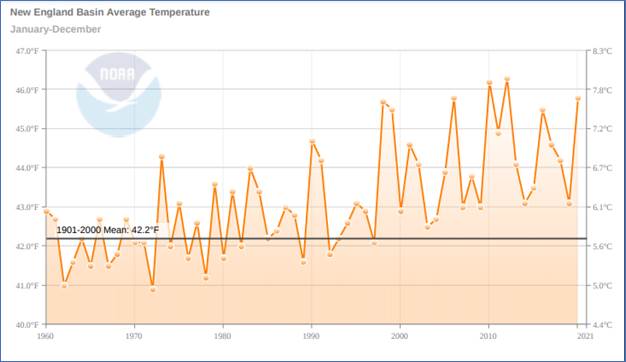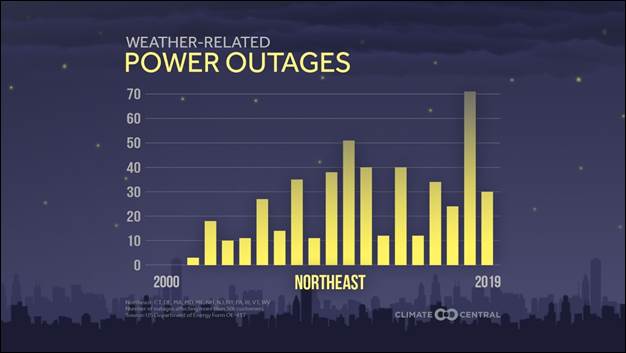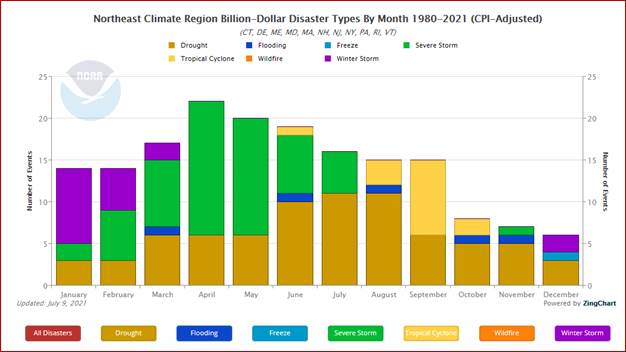
For many in Jamaica, Vermont, flood damage in August 2021 brought back memories of Tropical Storm Irene from 10 years earlier.
As we close out another summer under the growing influence of climate change, our ‘New Normal’ weather feels more like it’s bordering on the extreme. Inside New England:
- It was Massachusetts’ hottest and wettest summer on record. Many other New England locations also posted top 10 weather rankings on both counts.
- Three hurricanes – Elsa, Henri, and Ida – tracked over our area as they wrung out their tropical moisture, dropping up to a foot of rain in some locations while causing billions of dollars in property damage in the mid-Atlantic region.
- Closer to home, Concord, NH, racked up 13 inches of rain in July, and another 9 inches in August, both setting monthly records. Over the summer season, including June, Hartford, CT, received almost four feet of rain, also setting a seasonal record.
- In Vermont, parts of Bennington and Windham Counties saw 5 inches of rain in just a matter of hours on July 29, harkening back to flash floods that devastated much of the region during Tropical Storm Irene in August 2011.
While it may feel like we are heading into uncharted territory – and we are — it’s really part of a long-term trend that’s been altering our region’s climate for many decades. Consider:

- New England’s annual temperature average has gone up by more than 1.5 degrees (F) since 1960, with all 10 warmest years coming since 1998.
- Average annual rainfall – and the incidence of flash flooding – has also been rising throughout New England. In Vermont, annual precipitation has risen by more than 6 inches since 1960, and throughout the Northeast, flash flooding events have soared by 55 percent since 2000 – more than any other region in the nation.
- Given the rise in severe weather activity (including winter ice storms), the Northeast now leads the nation in the number of annual power outages caused by extreme weather events. Nationwide, weather-related power outages have grown by two-thirds since 2000 – and at an even faster pace here in New England.

With greenhouse gas emissions still priming the Earth’s heat pump, our extreme-weather woes are sure to continue. A climate assessment produced for the State of Vermont in 2014 correctly predicted that a rise in “blocking” or quasi-stationary weather patterns – caused in part from a loss of Arctic sea ice – would alter our jet stream and cause more prolonged episodes of intense rainfall, tropical heat, and even more extreme cold (e.g., the Polar Vortex).
Such a dire warning just got amplified in the latest report from the Intergovernmental Panel on Climate Change, a group of 1,500 scientists advising government policymakers. In their first global update since 2015, the IPCC warned that “many aspects of our climate system are [now] unprecedented over many centuries to many thousands of years.”
“With further global warming,” the IPCC cautioned, “every region is projected to increasingly experience concurrent and multiple changes in climatic impact-drivers.” These include: “increases in the frequency and intensity of hot extremes, marine heatwaves, and heavy precipitation, agricultural and ecological droughts in some regions, and proportion of intense tropical cyclones, as well as reductions in Arctic sea ice, snow cover and permafrost.”

In other words, our New Normal is anything but, and more billion-dollar weather disasters are headed our way. In a future post, we’ll take up the issue of “climate resiliency” and how you can build a home energy system that’s ready to respond to whatever Mother Nature throws at us.
To monitor climate and weather trends in your area, check out this interactive new tool from NOAA.
Solaflect Energy is your home energy management partner. We help you install clean and affordable solar electricity and home battery systems for a more resilient and climate-friendly future. Click here to contact us, or email info@solaflect.com, or call (802) 649-3700, or text (802) 308-3018. Together, the power is in our hands to make a difference!




